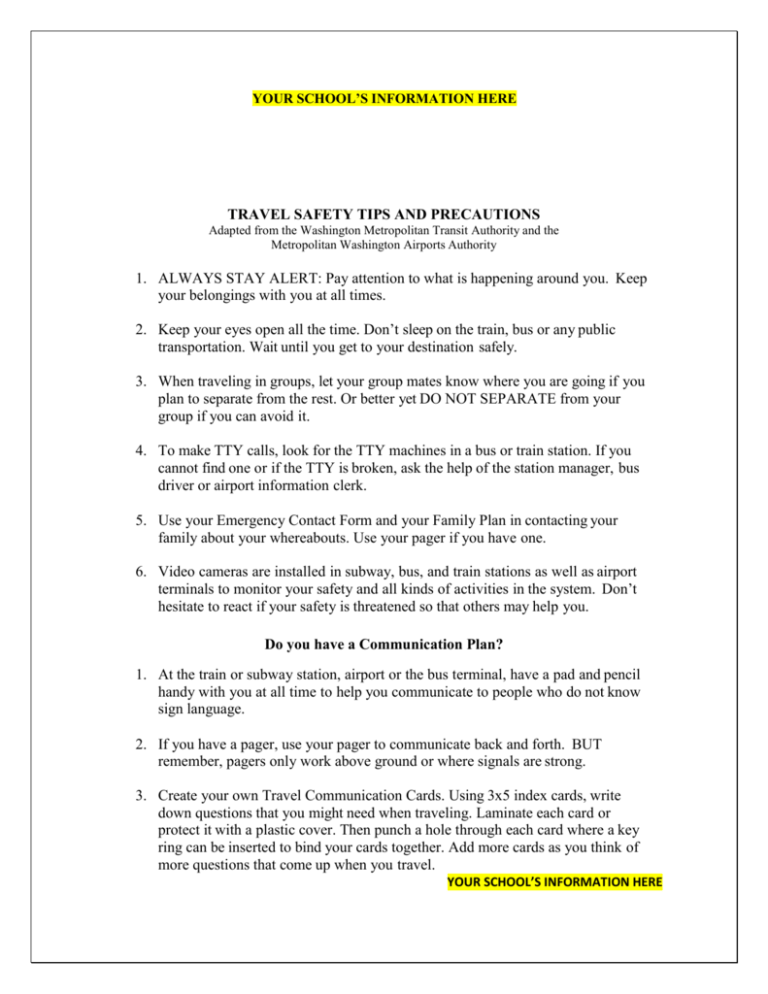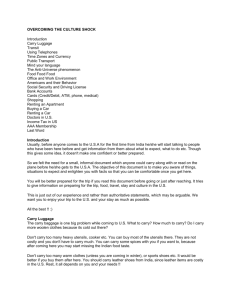Word
advertisement

YOUR SCHOOL’S INFORMATION HERE TRAVEL SAFETY TIPS AND PRECAUTIONS Adapted from the Washington Metropolitan Transit Authority and the Metropolitan Washington Airports Authority 1. ALWAYS STAY ALERT: Pay attention to what is happening around you. Keep your belongings with you at all times. 2. Keep your eyes open all the time. Don’t sleep on the train, bus or any public transportation. Wait until you get to your destination safely. 3. When traveling in groups, let your group mates know where you are going if you plan to separate from the rest. Or better yet DO NOT SEPARATE from your group if you can avoid it. 4. To make TTY calls, look for the TTY machines in a bus or train station. If you cannot find one or if the TTY is broken, ask the help of the station manager, bus driver or airport information clerk. 5. Use your Emergency Contact Form and your Family Plan in contacting your family about your whereabouts. Use your pager if you have one. 6. Video cameras are installed in subway, bus, and train stations as well as airport terminals to monitor your safety and all kinds of activities in the system. Don’t hesitate to react if your safety is threatened so that others may help you. Do you have a Communication Plan? 1. At the train or subway station, airport or the bus terminal, have a pad and pencil handy with you at all time to help you communicate to people who do not know sign language. 2. If you have a pager, use your pager to communicate back and forth. BUT remember, pagers only work above ground or where signals are strong. 3. Create your own Travel Communication Cards. Using 3x5 index cards, write down questions that you might need when traveling. Laminate each card or protect it with a plastic cover. Then punch a hole through each card where a key ring can be inserted to bind your cards together. Add more cards as you think of more questions that come up when you travel. YOUR SCHOOL’S INFORMATION HERE When Using the Escalator 1. Hold on to the handrails to keep your balance. Do not ride or lean on the handrail or play while on the escalator. Do not sit on the escalator steps. 2. Always stand straight. Keep your hands, feet and clothing away from any moving parts. 3. Do not drag your feet off the escalator steps. 4. When you reach the bottom or the top of the escalator, exit immediately. Do not stop or play. When Using Trains or At the Train Station 1. Know where the emergency exits are inside the train. During an emergency, written instructions will be electronically displayed inside the train and in train stations. 2. When waiting for a train, stand near other passengers. Do not stand on the platform edge. 3. When train doors are closing, do not try to enter the train because you can get caught while doing so. 4. Do not loiter in the platform area after exiting the train. 5. Do not display expensive jewelry or items when traveling. Hold on to your purse, and be careful with your backpack and wallets. 6. If you need directions or help, ask the station manager. If You are Lost 1. Go to the information or help desk, ticket counter or security/police officer and ask for help. 2. Tell them that you are lost. Show them your ticket and they will guide you to where you need to be or to board your bus, train or plane. If You Misplace or Lose Your Ticket or Boarding Pass 1. Go to the nearest ticket counter and explain your situation. 2. Be ready to show your photo ID to the ticket agent who will check if your name is on the list of passengers. Your ticket or boarding pass will be re-issued only with a photo ID. When Using Buses or At Bus Stations 1. If an emergency happens while you are inside a bus or at a bus station, DO NOT PANIC. Bus drivers and station personnel are trained to get help immediately. Wait for further instructions from them and from the police. 2. If you need help or have a problem while on a bus, write a note to the driver or the conductor. Using your Travel Communication Cards, explain what you need or the problem that you have to the driver or conductor. When Traveling by Air or Waiting at Airport Terminals 1. Before you leave for the airport, check your airline’s website for the status of your flight. This will help you avoid long waits in case your flight is delayed or cancelled. 2. Make sure you have a government-issued picture ID before you leave for the airport. Examples are: driver’s license, non­driver’s ID, passport, etc. Your school ID is not acceptable. 3. Arrive at the airport at least two hours before your scheduled flight to allow time to check-in and to complete all security screenings. On-line, Curb-side, or Self-Service Check-in at the Airport 1. You can use on-line check-in for your flight within 24 hours of your departure. Go to your airline’s website and follow the instructions for on­line check in. Print your boarding passes. You can use these boarding passes to check-in any luggage and to board your flight. 2. Curbside check-in. This is the easiest way to check yourself in with your luggage. Show your printed boarding pass (if you printed one) and your ID to the curb side attendant. He/she will check your luggage in. By using curb-side check-in, you avoid long waits at the check-in counters. (Be sure you tip a curbside attendant). 3. Self-service check-in at the airport. Inside the terminal are self-service check-in kiosks. You will need a state-issued ID or a credit/debit card so the machine can verify your identity. Follow on-screen instructions. An airline representative will give your boarding passes after you have satisfied all check-in requirements. (No tips here). Clearing Security before Your Flight 1. After checking-in, go through the security check point immediately. You must have your boarding pass and ID ready for inspection before you can clear security. 2. Strict security procedures are in place for the safety of each flight. Depending on the level of threat to passenger security, the TSA (Transportation Security Administration) has set guidelines on what passengers can take on board an airplane. For the most recent list of items that are not allowed and for items that you can carry on the plane, check: (http://www.tsa.gov/travelers/airtravel/prohibited/permitted-prohibiteditems.shtm#0) 3. All passengers and their carry-on bags must clear security before boarding any flight. The following items must pass through the x-ray machine at the security check point: a) ALL items in your pocket including pager, cell phone, keys, wallet, or any loose objects must be placed in a plastic bin to be x-rayed. b) Notebook computers must be placed in plastic bins to be x-rayed. c) Your carry-on bag, shoes (any kind), jackets, coats, or any outer garments must go through the x-ray machine. d) All liquids, gels and aerosols (up to 3 ounces) must be placed in a single, quart-size, zip-top, clear plastic bag (not bigger) and removed from your carry-on to be x-rayed. 4. If you wear hearing aids or have a cochlear implant, it is safe to go through the metal detectors. If you choose not to go through the metal detectors, request for a full-body search. Use your Travel Communication Cards to help you explain. 5. If you travel with a hearing dog or a service animal that must remain with you at all times, inform the TSA security screeners so they can help you. Show proper documentation supporting the need for a hearing dog or a service animal. 6. If you have prescription medication, any over-the-counter medication, liquids or gels, a needle or a syringe, place them in a separate bag properly identified and declare them to the TSA security screeners. Professional packaging or a pharmaceutical label will help identify what you are taking with you on board. There is no limit to how much of these you can bring with medical documentation. 7. Remove any kind of lighters and sharp objects longer than 4 inches, such as knives and scissors, from your carry-on bag. 8. Travel light. Limit your carry-on item to one, plus a purse or a briefcase. 9. After clearing security, go directly to your gate. Make sure that you have your boarding pass with you. Put your ID back in your wallet because you will not need it anymore. Waiting at the Gate for your Flight 1. When you arrive at the gate, inform the gate agent that you are deaf. Use your Travel Communication Cards to explain that you need to be informed of any announcements related to your flight, especially if your trip has been re-routed, delayed or cancelled. 2. Do not hesitate to remind the gate agent that you are waiting to board your flight. Stay close to where they can see you. Because they deal with many passengers, it is easy to forget about you. 3. Look for a TV monitor or screen close to your gate that provides flight updates and information. Check it frequently while waiting for any flight information. Do not just depend on the gate agent for information. Trip Cancellations 1. When your bus, train or flight is cancelled due to bad weather or some other reason, ask help from the bus, train or airline representative. They will try to book you on the next available trip. 2. When you have a new departure schedule, call home and let them know of the changes in your trip. Provide them with your new departure schedule. 3. If there are no other trips available for the same day, the ticket agent will book you on the next trip the following day. 4. If cancellation is weather-related, airlines do not have to pay for your hotel. But you can ask for help especially if you do not have money to pay for a hotel. 5. Call home and let them know your trip has been cancelled for the day. Let your family know if you are going to a hotel or if you will need a place to stay for the night. When traveling always remember to relax and enjoy the trip. If you have a problem or an emergency: 1. 2. Stay calm. Follow the tips in your wallet. 3. 4. Call home and keep them updated. Ask for HELP. YOUR SCHOOL’S INFORMATION HERE 1






